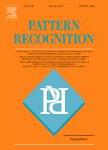版权所有:内蒙古大学图书馆 技术提供:维普资讯• 智图
内蒙古自治区呼和浩特市赛罕区大学西街235号 邮编: 010021

作者机构:Univ Sydney Sch Elect & Informat Engn Sydney NSW 2006 Australia City Univ Hong Kong Dept Elect Engn Kowloon Hong Kong Peoples R China
出 版 物:《PATTERN RECOGNITION》 (图形识别)
年 卷 期:2002年第35卷第6期
页 面:1371-1387页
核心收录:
学科分类:0808[工学-电气工程] 08[工学] 0812[工学-计算机科学与技术(可授工学、理学学位)]
主 题:fractal image coding contractivity factor eventual convergence object recognition fractal neighbor distance fractal neighbor classifier human face recognition
摘 要:Fractal image coding has been used successfully to compress and segment images, and more recently, utilized in a new distance measure to recognize objects. This paper discusses how the process of decoding a set of region-based contractive transformations has invariance properties that can be advantageous in object recognition. We will show that the recognition ability of the proposed fractal neighbor classifier (FNC), utilizing the fractal neighbor distance (FND) measure is a function of the contrast scaling factor and the illumination shift factor. Our investigation of the FND required accurate control over the convergence of a fractal decoding process. Convergence can be determined by examining the contractivity and eventual contractivity factors. We have derived theorems that allow these two factors to be calculated for a general class of fractal codes consisting of affine trans formations with integral geometric scaling. Experiments were performed that verified our ability to control and modify these convergence properties. Furthermore, experiments on human face recognition revealed that the performance of the FNC improved through the use of eventual convergence and the imposition of limits on the illumination shift factor. (C) 2002 Pattern Recognition Society. Published by Elsevier Science Ltd. All rights reserved.